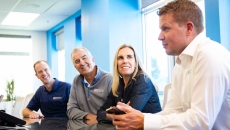Bill Siwicki
AI & ML Intelligence
Dr. Tim O'Connell, physician CEO of emtelligent, offers his view of what's needed to ensure artificial intelligence can work safely, effectively and transparently in healthcare settings.
Why are the two often so disconnected? And what role can technology play in integrating them? A new CMS accountable care program aims to drive progress, and one expert explains what it means for providers.
AI & ML Intelligence
Andy Sajous, a leader in digital transformation, explains. He discusses the trade-offs of building versus buying artificial intelligence tools and describes some crucial actions CIOs should take going into 2025.
Remote Patient Monitoring
The combination of 5G and IoT could redefine remote healthcare, getting closer to a future where patients can receive hospital-grade care from anywhere. And more user-friendly and patient-centered devices should drive broader adoption.
AI & ML Intelligence
And cybersecurity too. "I would definitely encourage folks to go deeper into those other areas and broaden their capabilities overall," says the chief AI adviser at UC Davis Health to those who might want to tackle a similar role.
AI & ML Intelligence
You can't just toss AI onto the CIO or CTO titles. Overseeing artificial intelligence in clinical and business environments, standing up a governance structure, and managing portfolios of tools for different patient types requires deep experience.
AI & ML Intelligence
A healthcare artificial intelligence expert also discusses foundational first steps hospitals and health systems should take when looking to adopt AI and how AI can be used to free up time and fight burnout for staff.
Success Stories & ROI
The tools have helped the health system grow demand for data-driven healthcare services, measure member attribution, and gain significant cost savings from identifying and acting on key healthcare utilization patterns.
Remote Patient Monitoring
The strategy has had a big impact on patient access, bed capacity, and heart failure and all-cause readmissions – not to mention appreciation of patients and family thankful to receive care safely at home instead of having to be admitted to the hospital.
Success Stories & ROI
With automation, turnaround times are now 40-45 days – way down from 90-120, previously. And before the tools were in place, the team was credentialing eight applicants per month – now that number is 35.










